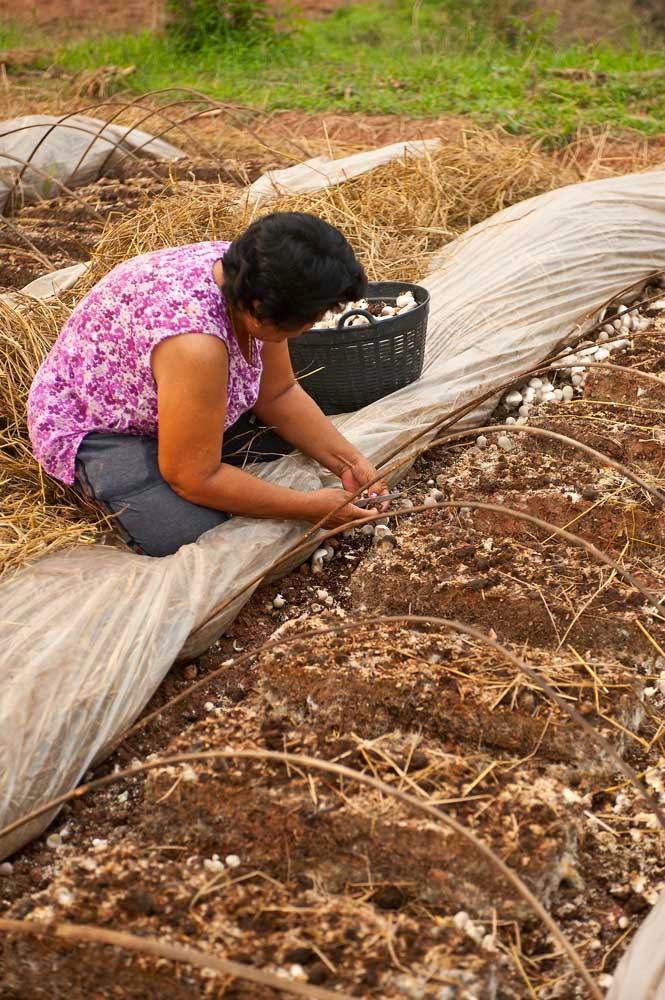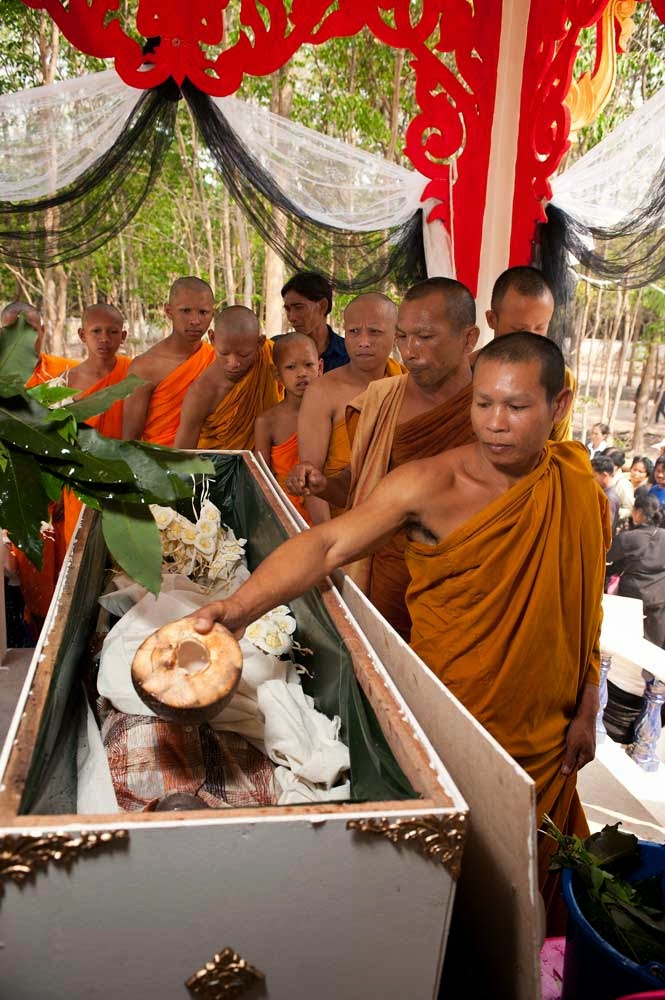This blog was a long time in coming. I started to write the blog eleven days ago, but I was not certain regarding the facts and details of the process for cultivating mushrooms here in Northeast Thailand.
Thanks to the wonders of the Internet and Google, I found some excellent information related to how mushrooms are supposed to be grown here. An excellent source was the "Mushroom Grower's Handbook" 2004 by MushWorld (if some one knows about how mushrooms are supposed to be grown is has got to be these guys!)
The sugar cane harvest is winding down now, but outside of the Kumphawapi Sugar Cane Company, there are huge mounds of waste - "bagasse" - a waste product that Duang and I refer to as "key oi" (sugar shit). Bagasse smells sickening - a combination of extremely smelly feet and overpowering sweetness. Bagasse is composed of fiber, moisture, and soluble solids. It is roughly one-half cellulose, one-third carbon, one percent nitrogen, with some potassium and phosphorous.
Often during our travels out to Duang's village we see people picking through the fresh moist mounds of bagasse seeking out mushrooms. Local farmers also purchase truckloads of the waste to add to their land as a soil conditioner.
My research indicated that sugar bagasse is used as a substrate for cultivating oyster mushrooms. I became comfortable in my belief that Duang's relatives were growing oyster mushrooms. Delving further into the handbook, Chapter 5, I started to have my doubts regarding the mushroom process in Isaan that I had observed previously. The handbook showed substrate being made and placed in small plastic bags that would then get inoculated with spawn. It outlined spawn preparation. The chapter also discussed incubation as well as pasteurization.
 |
| Duang's Aunt Preparing Mushrooms |
With that information, I returned to my Internet research, this time- Chapter 2 of the handbook. Lo and behold, there was a table, Table 1, that was a list of commercially cultivated mushrooms in Thailand. In addition to the common name, and Latin name the table provided the Thai name for the mushroom. The last entry in the table was "Hed Fang" - Straw mushroom. Things were starting to make more sense - I had seen rows of straw mounds where underneath I knew mushrooms were growing.
The remainder of the chapter provided details that confirmed some of my observations, straw mushrooms being grown from December to April but a great detail of information no where near what I had seen on my trips out to the family mushroom plot.
It turns out that mushroom cultivation here in Isaan is another example of "The ways that things are supposed to be and the way that they really are."
I have written several times about the duality and dichotomy of life here in Isaan, I now realize that it also applies to matters other than religion, morality, ethics, and politics.
Aside from the way mushrooms are supposed to be cultivated, I will now share how they are cultivated by Duang's family along with several other villagers that I have observed.
 |
| Duang's Aunt Processing Straw Mushroom Spawn |
Placed on the ground off to her right, were several large Kraft paper bags each packed solid with several clear plastic bags. The plastic bags were stuffed with a moist organic mass and the ends were secured with PVC plastic collars. The bags looked exactly like the bags used to grow mushrooms the way that they are supposed to according to the handbook - but not the Tahsang Village way.
Duang's aunt was busy removing the PVC collar from the bags and pulling the compressed organic cylinders from the polypropylene bags. A large plastic tub, in front of her, rested on the platform. The tub had seen better days - about 50% of its rim had become detached from the thin walls of the container. However the tub still was fit for many purposes, just not as many as previously.
A grating, perhaps a recycled oven rack or part of a display case covered part of the black tub. After freeing the cylinders from their confines of the bags, Duang's aunt broke them up with her hands along with the action of running them back and forth across the grating. Broken organic matter accumulated in the tub beneath the grating.
We dropped by the mushroom plot at 4:00 P.M. The sun sets around 5:30 P.M. so the temperature was more bearable.
 |
| Kwan, Pare, and Their Grandfather Arrive to Work On Mushrooms |
The first task was to remove the polyethylene plastic sheet covering each row. Removing the sheeting carefully off to the side of each row revealed a line of compacted rectangles of what I assumed to be sugar bagasse for the substrate to grow the mushrooms. Wrong! I checked with Duang's uncle and it turned out that the blocks were actually formed out of cassava waste from the local mill. I asked about what layers of other components did he use to make the rectangular blocks - the handbook had listed the layers and components to construct blocks. Oh I forgot ... that is the way that they are supposed to be constructed. The way that they are actually constructed, at least in Tahsang Village, is to put cassava processing waste in a wood form and compact it to form the free standing substrates.
Once the substrates in a row had been uncovered, Duang's uncle walked down the row sprinkling by hand the material that his wife had prepare earlier in the day.
 |
| Sprinkling Spawn on Substrates |
Three days later the plastic sheet was removed from the rows and after hand made home made bamboo strips where installed to form hoops along the row, the sheeting was placed over the row of substrates. A thick mat of rice straw was placed over the tent row formed by the hoops and plastic sheet.
 |
| Mushrooms Ready For Harvest |
Three separate crops of mushrooms are produced from a row - each crop about 3 days apart.
 |
| Preparing Harvested Mushrooms for Market. |
I am continually impressed in the ability of the Lao Loum people here in Isaan to do what is necessary to care for themselves and family. I have seen them grow rice, cultivate corn, sugar cane, peanuts and cassava. They weave their own fishnets, and baskets.
The people are very resourceful and self-reliant. I consider myself very fortunate to be able to observe and document this way of life. I consider it to be my responsibility to share this way of life with others if for no other reason than to educate others as to how others live.



























































